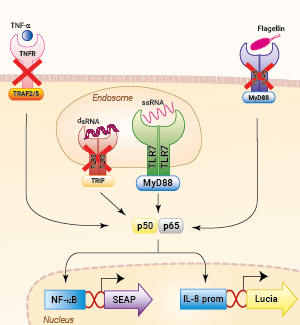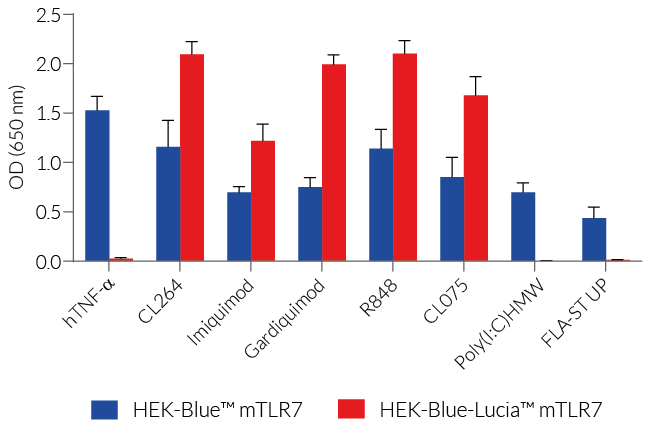Mouse TLR7 HEK293 Reporter Cells (NF-κB and IL-8)
| Product | Unit size | Cat. code | Docs. | Qty. | Price | |
|---|---|---|---|---|---|---|
|
HEK-Blue-Lucia™ mTLR7 Cells Murine TLR7 expressing HEK293 dual reporter cells (NF-κB pathway) |
Show product |
3-7 x 10e6 cells |
hkd-mtlr7ni
|
|
||
|
HEK-Blue-Lucia™ mTLR7 vial Additional cell vial |
Show product |
3-7 x 10e6 cells |
hkd-mtlr7ni-av
|
Notification: Reference #hkd-mtlr7ni-av can only be ordered together with reference #hkd-mtlr7ni.
NF-κB–SEAP and IL-8–Lucia reporter HEK293 cells expressing murine TLR7

Signaling pathways in HEK-Blue-Lucia™ mTLR7 cells
HEK-Blue-Lucia™ mTLR7 cells were engineered from the human embryonic kidney HEK293 cell line to study the mouse Toll-like receptor 7 (TLR7). This important pattern recognition receptor (PRR) recognizes viral single-stranded RNA (ssRNA) structures and subsequently triggers NF-κB and IRF immune responses [1].
Description
HEK-Blue-Lucia™ mTLR7 cells were generated from the HEK-Blue-Lucia™ Null cell line harboring two inducible reporter genes. This feature allows the double readout of the NF-κB/AP-1 pathway, by monitoring the SEAP (secreted embryonic alkaline phosphatase) or Lucia luciferase activities. HEK-Blue-Lucia™ mTLR7 cells also stably express the mTLR7 gene. Due to a triple knockout (KO) of TLR3, TLR5, and TNFR, this cell line allows for the independent study of TLR7.
Stimulation of HEK-Blue-Lucia™ mTLR7 cells with TLR7 agonists (e.g. R848) triggers the activation of the artificial NF-κB-inducible promoter and the subsequent production of SEAP. It also promotes the expression of Lucia luciferase, which is knocked in (KI) downstream of the endogenous (more physiological) IL-8 promoter (see figures).
IL-8 (interleukin 8) is a chemokine produced in response to TLR agonists in an NF-κB/AP-1-dependent manner [2-3]. This feature enables the double readout study of the NF-κB/AP-1 pathway, by monitoring the activity of SEAP and Lucia luciferase using QUANTI-Blue™ Solution (SEAP detection reagent) or QUANTI-Luc™ 4 Lucia/Gaussia (luciferase detection reagent), respectively. Thus, you may choose the readout depending on your laboratory equipment utilizing a spectrophotometer for SEAP or a luminometer for Lucia luciferase detection.
![]() Read our review on TLR7 & TLR8
Read our review on TLR7 & TLR8
Key features
- Stable overexpression of mTLR7
- Verified KO for the TLR3, TLR5, and TNFR genes
- Functionally validated using a selection of PRR ligands and cytokines
- Readily assessable NF-κB activation by assessing the SEAP and/or Lucia luciferase activities
Applications
- Defining the role of TLR7-dependent NF-κB signaling pathway
- Screening for novel TLR7 agonists and inhibitors
- Choice of readout depends on the laboratory equipment (spectrophotometer for SEAP or luminometer for Lucia luciferase detection).
* Note: This cell line has been renamed. It was formerly known as "HEK-Dual™ mTLR7 (NF/IL8)". The cat. code remains (hkd-mtlr7ni) unchanged.
References:
1. Georg P. & Sander L.E., 2019. Innate sensors that regulate vaccine responses. Curr. Op. Immunol. 59:31.
2. Roebuck KA. 1999. Regulation of interleukin-8 gene expression. J Interferon Cytokine Res:429-38.
3. Ohta K, et al. 2014. Toll-like receptor (TLR) expression and TLR‑mediated interleukin-8 production by human submandibular gland epithelial cells. Mol Med Rep. (5):2377-82.
Specifications
Antibiotic resistance: Blasticidin, Hygromycin, Zeocin®
Growth medium: DMEM, 4.5 g/l glucose, 2 mM L-glutamine, 10% (v/v) heat-inactivated fetal bovine serum, 100 U/ml penicillin, 100 μg/ml streptomycin, 100 μg/ml Normocin™
Quality Control:
- The stable expression of mTLR7 has been verified by RT-qPCR and functional assays.
- The triple KO of TLR3, TLR5, and TNFR has been verified by DNA sequencing, PCR, and functional assays.
- The stability for 20 passages, following thawing, has been verified.
- These cells are guaranteed mycoplasma-free.
Note: HEK-Blue-Lucia™ mTLR7 cells are resistant to Blasticidin, Hygromycin, and Zeocin®. They should be maintained in growth medium supplemented with Hygromycin and Zeocin®.
Back to the topContents
- 3-7 x 106 cells in a cryovial or shipping flask.
- 1 ml of Hygromycin B Gold (100 mg/ml)
- 1 ml of Zeocin® (100mg/ml)
- 1 ml of Normocin™ (50 mg/ml)
- 1 ml of QB reagent and 1 ml of QB buffer (sufficient to prepare 100 ml of QUANTI-Blue™ Solution, a SEAP detection reagent)
- 1 tube of QUANTI-Luc™ 4 Reagent, a Lucia luciferase detection reagent (sufficient to prepare 25 ml)
![]() Shipped on dry ice (Europe, USA, Canada, and some areas in Asia)
Shipped on dry ice (Europe, USA, Canada, and some areas in Asia)
Details
Four Toll-Like Receptor (TLR) family members TLR3, TLR7, TLR8, and TLR9, mainly found in the endosome, are specialized in sensing viral-derived components. In humans, TLR7 and TLR8 recognize single-stranded (ss)RNA structures, such as viral ssRNA, miRNA, and various synthetic agonists [1]. Despite their similarities in PAMP (pathogen-associated molecular pattern) recognition, structure, and signaling partners, they highly differ in expression profiles and signaling responses, with TLR7 being more involved in the antiviral immune response and TLR8 mastering the production of proinflammatory cytokines [2]. In mice, TLR8 has been less studied than TLR7 as it was initially thought to be non-functional in mice [3]. Importantly, due to species-specific differences, findings regarding mouse TLR7 and TLR8 are not easily transposable to their human counterparts [3].
Upon viral infection, TLR7 translocates from the endoplasmic reticulum via the Golgi into the endosomes. Subsequently, it undergoes proteolytic cleavage and dimerization [1,4]. Once activated, it recruits the adaptor protein MyD88 to trigger IRF, AP-1, and NF-kB responses via TRAF6 (TNF receptor-associated factor 6) [1,4]. Depending on the stimulus and cell type, TLR7-mediated signaling induces IFN-α and IFN-regulated cytokines or T helper 17 (Th17) polarizing cytokines, such as interleukin (IL)-1β and IL-23 [5]. The involvement of nucleic acid-sensing mechanisms in the immune response against infections and other diseases makes them interesting targets for drug design [5]. TLR7 agonists are currently been tested as vaccine adjuvants and immunomodulatory therapeutics. They are extensively studied in the context of viral infection (e.g. SARS-CoV-2, Influenza, HIV), autoimmune (e.g. asthma, Lupus), and autoinflammatory diseases (e.g. cancer) [1-5]. Understanding the fundamental differences between these two related receptors could potentially be harnessed to discover novel drugs and improve vaccine efficacy/safety [5].
References:
1. Martínez-Espinoza I & Guerrero-Plata A. 2022. The Relevance of TLR8 in Viral Infections. Pathogens. 11(2):134.
2. Salvi V, et al., 2021. SARS-CoV-2-associated ssRNAs activate inflammation and immunity via TLR7/8. JCI Insight.;6(18):e150542.
3. Heil F. et al., 2004. Species-specific recognition of single-stranded RNA via Toll-like receptor 7 and 8. Science. 303:1526.
4. Georg P. & Sander L.E., 2019. Innate sensors that regulate vaccine responses. Curr. Op. Immunol. 59:31.
5. de Marcken M, et al., 2019. TLR7 and TLR8 activate distinct pathways in monocytes during RNA virus infection. Sci Signal.;12(605):eaaw1347.








